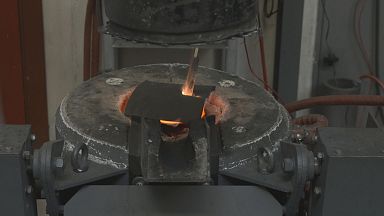Futuris meets the researchers attempting to store energy at ultra high temperatures.
In this episode, the Futuris team meet the researchers attempting to store energy at ultra high temperatures.
Is it possible to store energy at extremely high temperatures of up to 2000ºC? What are the advantages of having such technology? And what are the challenges when it comes to developing it? These are just some of the burning questions scientists from the Amadeus research project are trying to answer at an experimental foundry in Norway.
Developing a new generation of storage devices
Careful preparation is needed before melting metal alloys at 1700ºC. It is at this extreme heat that scientists want to find out if it is possible to produce electricity from thermal energy.
"We started with the materials that have the higher difference in energy between the liquid and solid states. And that is kind of the main effect that we are looking for. And the reason why this is so important is because we can store a lot of energy in very short volumes," says Merete Tangstad, from the Norwegian University of Science and Technology.
Creating a safe, reliable process
Ultra-high temperatures shift the heat transfer process from convection to radiation. But this process has to be as efficient, reliable, stable and as safe as possible in order to avoid both accidents, technical failures and energy waste. For that reason, real-time monitoring is crucial.
Materials scientist Natalia Sobczak from the Polish Foundry Research Institute explains: "At high temperatures, everything reacts with everything. And each of these reactions can cause huge changes in the container´s properties, even resulting in its cracking. Ideally we are looking for the right conditions to guarantee controlled chemical reactions during the melting process."
Building a low-cost thermal power station
In Madrid, additional research is being carried out to manufacture the first complete systems. Researchers hope their work could soon turn into a low-cost thermal power station where energy from sustainable sources could be stored in latent-heat batteries in order to provide electricity.
"We can store between 1 to 2 kilowatts an hour per litre. That´s around 10 fold what a conventional electrochemical battery is able to store. All the energy that you are producing during that melting process is an energy that's not wasted. It is an energy that you are storing in the form of heat," says Amadeus' scientific project coordinator Alejandro Datas.
Maximising the conversion of such stored heat into electricity is key. For that to happen, researchers need to pay particular attention to the electrons.
"When a given material reaches a certain high temperature, it releases electrons. Our objective is to help release those electrons in an efficient way at a not too high temperature. In this way, we can maximize the conversion of thermal energy into electricity. The electrons are the conveyors of electricity," says electrical engineer, Daniele Maria Trucchi.
The scientists first prototype is putting the theory into practice. Made from fewer components, the cost of installation and maintenance remains relatively cheap. If tests prove conclusive, researchers think it could go to market.
"The advantage of building small systems, is that we are able to sell many units, to increase production and to greatly improve our learning curve. In the short term, let's say five years, that will allow us to introduce this new technology onto the market," explains Datas.
Watch our Instagram Story:












